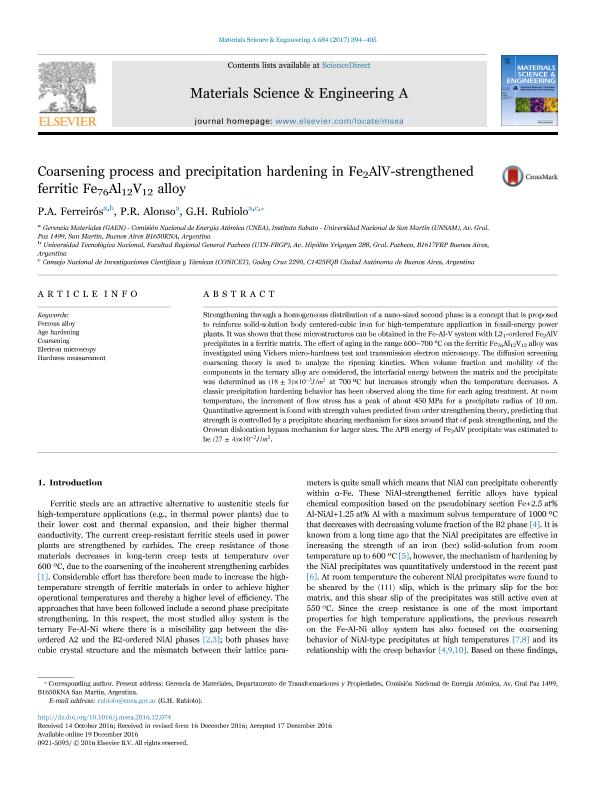Mostrar el registro sencillo del ítem
dc.contributor.author
Ferreirós, Pedro Antonio

dc.contributor.author
Alonso, Paula Regina

dc.contributor.author
Rubiolo, Gerardo Hector

dc.date.available
2019-03-29T20:12:16Z
dc.date.issued
2017-01
dc.identifier.citation
Ferreirós, Pedro Antonio; Alonso, Paula Regina; Rubiolo, Gerardo Hector; Coarsening process and precipitation hardening in Fe2AlV-strengthened ferritic Fe76Al12V12 alloy; Elsevier Science Sa; Materials Science and Engineering A: Structural Materials: Properties, Microstructure and Processing; 684; 1-2017; 394-405
dc.identifier.issn
0921-5093
dc.identifier.uri
http://hdl.handle.net/11336/72874
dc.description.abstract
Strengthening through a homogeneous distribution of a nano-sized second phase is a concept that is proposed to reinforce solid-solution body centered-cubic iron for high-temperature application in fossil-energy power plants. It was shown that these microstructures can be obtained in the Fe-Al-V system with L21-ordered Fe2AlV precipitates in a ferritic matrix. The effect of aging in the range 600–700 °C on the ferritic Fe76Al12V12 alloy was investigated using Vickers micro-hardness test and transmission electron microscopy. The diffusion screening coarsening theory is used to analyze the ripening kinetics. When volume fraction and mobility of the components in the ternary alloy are considered, the interfacial energy between the matrix and the precipitate was determined as (18±3)×10−3J/m2 at 700 ºC but increases strongly when the temperature decreases. A classic precipitation hardening behavior has been observed along the time for each aging treatment. At room temperature, the increment of flow stress has a peak of about 450 MPa for a precipitate radius of 10 nm. Quantitative agreement is found with strength values predicted from order strengthening theory, predicting that strength is controlled by a precipitate shearing mechanism for sizes around that of peak strengthening, and the Orowan dislocation bypass mechanism for larger sizes. The APB energy of Fe2AlV precipitate was estimated to be (27±4)×10−2J/m2.
dc.format
application/pdf
dc.language.iso
eng
dc.publisher
Elsevier Science Sa

dc.rights
info:eu-repo/semantics/openAccess
dc.rights.uri
https://creativecommons.org/licenses/by-nc-nd/2.5/ar/
dc.subject
Age Hardening
dc.subject
Coarsening
dc.subject
Electron Microscopy
dc.subject
Ferrous Alloy
dc.subject
Hardness Measurement
dc.subject.classification
Otras Ingeniería de los Materiales

dc.subject.classification
Ingeniería de los Materiales

dc.subject.classification
INGENIERÍAS Y TECNOLOGÍAS

dc.title
Coarsening process and precipitation hardening in Fe2AlV-strengthened ferritic Fe76Al12V12 alloy
dc.type
info:eu-repo/semantics/article
dc.type
info:ar-repo/semantics/artículo
dc.type
info:eu-repo/semantics/publishedVersion
dc.date.updated
2019-03-29T12:12:56Z
dc.journal.volume
684
dc.journal.pagination
394-405
dc.journal.pais
Países Bajos

dc.journal.ciudad
Amsterdam
dc.description.fil
Fil: Ferreirós, Pedro Antonio. Universidad Nacional de San Martín; Argentina. Universidad Tecnológica Nacional. Facultad Regional General Pacheco; Argentina. Comisión Nacional de Energía Atómica; Argentina
dc.description.fil
Fil: Alonso, Paula Regina. Universidad Nacional de San Martín; Argentina. Comisión Nacional de Energía Atómica; Argentina
dc.description.fil
Fil: Rubiolo, Gerardo Hector. Universidad Nacional de San Martín; Argentina. Comisión Nacional de Energía Atómica; Argentina. Consejo Nacional de Investigaciones Científicas y Técnicas; Argentina
dc.journal.title
Materials Science and Engineering A: Structural Materials: Properties, Microstructure and Processing

dc.relation.alternativeid
info:eu-repo/semantics/altIdentifier/doi/http://dx.doi.org/10.1016/j.msea.2016.12.074
dc.relation.alternativeid
info:eu-repo/semantics/altIdentifier/url/https://www.sciencedirect.com/science/article/pii/S0921509316315775
Archivos asociados
